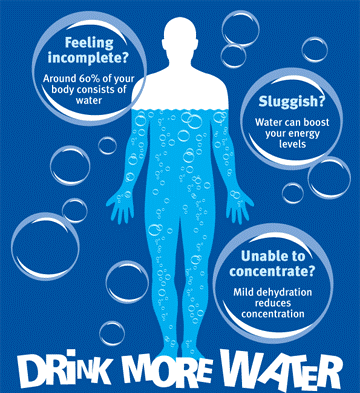
Are you dehydrated?
July 14, 2014
 What is hydration / dehydration?
What is hydration / dehydration?
On the average, water makes up 60 – 70% of your body weight. The range is due to the fact that different cells contain different amounts of water. Muscle cells, for example, are 70-75% water whereas fat cells are only 10-15% water. Therefore, a muscular person will have a larger percentage of his/her body weight coming from water.
Dehydration is usually expressed as the loss of a certain percentage of one’s weight. Scientists define dehydration as fluid losses greater than only 1% of body weight. Water is lost first from the blood which is 90% water. If water deprivation continues, cells will start to lose their water content. Dehydration can become fatal when 9-12% of your body weight is lost via water.
Why is being hydrated so important?
- To answer this question, consider the following functions of water in our bodies:
- in saliva and stomach secretions it helps to digest food
- in blood, it helps transport nutrients and oxygen to all the cells of the body
- in body fluids, it helps lubricate joints and cushions organs and tissues · in urine, it carries waste products out of the body
- in sweat, it removes body heat generated during exercise
Drinking plenty of water is also important for healthy skin. Sometimes our body confuses a thirst signal for a hunger signal, which is why drinking a glass of water before a meal or snack is a common weight management tip.
Why is it so hard to stay hydrated?
Our bodies are constantly losing water. The most obvious way is through daily urine output. If you exercise, you sweat. Studies of athletes have shown sweat losses of 2 quarts per hour while exercising! Most of us will lose less than that on our daily walk/run, but sweating is still a large source of water loss. Even when not exercising we are losing water through our skin – this is called ‘insensible losses’. Other insensible losses are through respiration and feces.
Another reason we have a hard time staying hydrated is that our thirst mechanism has a sort of lag time. Once we are thirsty, our bodies have already reached the point of moderate dehydration, and it becomes more difficult to replenish the fluids to the point of hydration.
How do you know if you’re hydrated or dehydrated?
The best way to tell if you’re hydrated is to monitor your urine. You should be urinating a significant amount regularly (3-4 times) throughout the day. If your urine is pale yellow or clear in color you are drinking enough. If it is dark yellow and odorous you are dehydrated.
The first sign of dehydration is thirst. Other signs of moderate dehydration are low grade headache and fatigue. Severe dehydration is accompanied by nausea, chills, increased heart rate, inability to sweat, and lightheadedness. At this point, medical attention is warranted.
How much water do I need?
Again, it depends on who you are. A rule of thumb that you may have heard is no less than 64 oz. per day. That’s about 8 glasses of water per day if you prefer to think of it that way. This amount would probably be adequate for someone who lived in a temperate climate and more if you live in a warmer climate.
Water needs are also related to how many calories you burn daily. You need about 1 ml of water for every calorie you burn. So, if you’re very active and burn 3000-4000 calories per day, you would need 3-4 liters of water (13-17 cups) If you exercise, weigh yourself before and after your workout. For every pound lost, drink at least 2 cups or 16 oz. of water. It’s also a good idea to get 1-2 cups of fluid 15-30 minutes before you workout.
Most people are a bit shocked when they discover how much fluid they need. Luckily, you get some fluids from foods you eat (especially fruits and veggies), and from non-caffeinated beverages (fruit juice, sports drinks, milk, vegetable juice, herbal teas). Remember caffeine and alcohol are both diuretics, and contribute to dehydration. So, ALL your fluid intake doesn’t necessarily have to come from water – although that is the easiest and (usually) the cheapest way.
A lot of people have questions about which kind of water they should be drinking. Generally speaking, tap water is safe in North America. If you are concerned about your tap water, you can contact the water company and get a report on the contamination level and also how the water is treated. If your tap water tastes funny, it’s a great idea to invest in a water filter – they are relatively inexpensive and can be attached to the faucet. Bottled water is generally safer than tap water, but did you know that 25% of bottled water comes from a municipal source? Look at label information to make sure your water comes from a well or a spring vs. a community or municipal source. There several different types of bottled water: mineral water, spring water, purified water, sparkling water, and sterilized water.
Mineral water – contains dissolves minerals like calcium, magnesium, iron, and sodium – not a bad choice for women who need as much iron and calcium as they can get!
Purified water A.K.A. distilled water – has all its minerals removed.
Sparkling water – is naturally carbonated.
Spring water – is from an underground source where water flows naturally.
Sterilized water – is the cleanest water. It is used mainly for infant formulas and for immune-compromised patients in hospitals.




